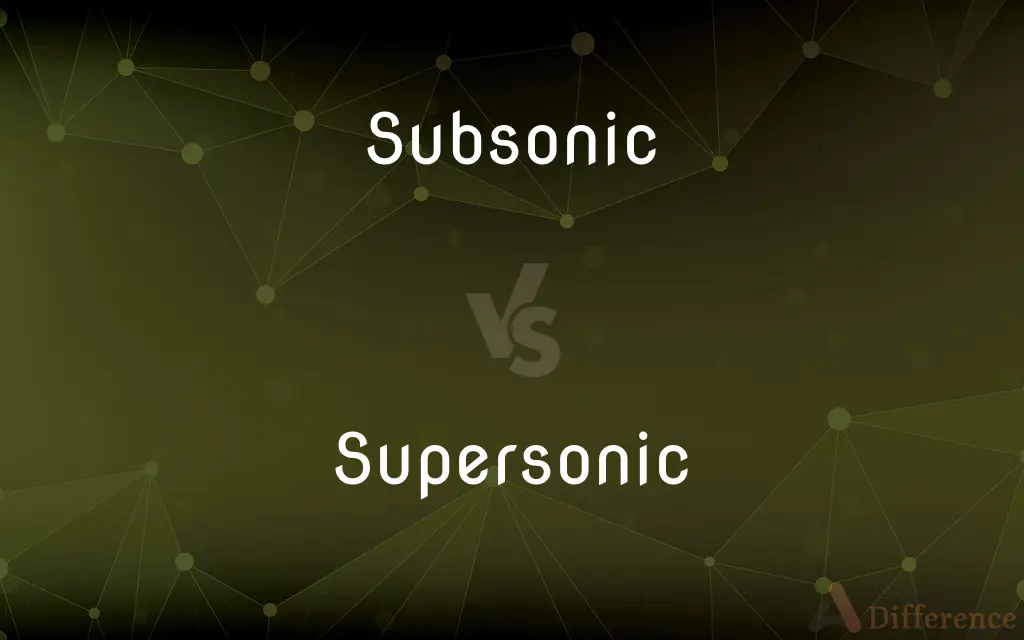Subsonic vs. Supersonic — What's the Difference?
By Tayyaba Rehman — Updated on September 28, 2023
"Subsonic" refers to speeds below the speed of sound, while "Supersonic" denotes speeds exceeding the speed of sound.

Difference Between Subsonic and Supersonic
Table of Contents
ADVERTISEMENT
Key Differences
"Subsonic" and "Supersonic" are terms used in aerodynamics to describe velocities concerning the speed of sound. When something travels at a "Subsonic" speed, it moves slower than the sound waves it generates. This results in sound waves moving ahead of the object, ensuring that one can hear an approaching "Subsonic" object before seeing it.
"Supersonic," on the contrary, describes velocities that surpass the speed of sound. An object moving at a "Supersonic" speed will outpace the sound waves it produces. The compression of these waves is responsible for the sonic boom often associated with "Supersonic" speeds. Consequently, a "Supersonic" jet will pass by before its sound reaches an observer on the ground.
It's essential to understand the significance of the speed of sound in these definitions. In standard atmospheric conditions at sea level, the speed of sound is about 343 meters per second (1,125 feet per second). If an object's speed remains below this threshold, it is "Subsonic." If it exceeds this value, it's "Supersonic."
To delve deeper, aircraft and other objects can experience both "Subsonic" and "Supersonic" conditions. For instance, during acceleration, an aircraft might transition from "Subsonic" to "Supersonic" speeds, breaking the sound barrier in the process.
Comparison Chart
Speed Relative to Sound
Below the speed of sound.
Above the speed of sound.
ADVERTISEMENT
Sound Waves
Move ahead of the object.
Lag behind the object.
Audibility
Object's sound heard before it's seen.
Object seen before its sound is heard.
Associated Phenomenon
No distinct sonic occurrence.
Produces a sonic boom.
Typical Usage
Commercial air travel, general aviation.
Military jets, experimental aircraft.
Compare with Definitions
Subsonic
Pertaining to velocities slower than sound waves.
The drone's subsonic motor was almost silent.
Supersonic
Denoting motion where the object precedes its sound.
The supersonic jet was visible long before its roar was heard.
Subsonic
Denoting motion where sound precedes the object.
The subsonic car's engine roar was heard before it appeared on the horizon.
Supersonic
Speeds surpassing the speed of sound.
The fighter jet can reach supersonic speeds.
Subsonic
Relative to conditions or movements below sound speed.
Subsonic wind tunnels are used for specific aerodynamic testing.
Supersonic
Characterized by exceeding the threshold of audible sound speed.
The aircraft's supersonic flight caused a loud sonic boom.
Subsonic
Speeds less than the speed of sound.
Most commercial airliners operate at subsonic speeds.
Supersonic
Pertaining to velocities faster than sound waves.
The missile traveled at supersonic speeds to its target.
Subsonic
Characterized by being under the threshold of audible sound speed.
Subsonic ammunition is favored for its reduced noise.
Supersonic
Relative to conditions or movements above sound speed.
Supersonic aerodynamics is a specialized field of study.
Subsonic
Relating to or flying at a speed or speeds less than that of sound
Subsonic aircraft
Supersonic
Involving or denoting a speed greater than that of sound
The tip speed of the upwind blade becomes supersonic
Supersonic aircraft
Subsonic
Of less than audible frequency.
Supersonic
Having, caused by, or relating to a speed greater than the speed of sound in a given medium, especially air.
Subsonic
Having a speed less than that of sound in a designated medium.
Supersonic
Of or relating to sound waves with a frequency above the range audible to the human ear; ultrasonic.
Subsonic
(of a sound, scientific) having a frequency too low to be audible
Supersonic
(of a speed) Greater than the speed of sound (in the same medium, and at the same temperature and pressure).
Subsonic
(of a sound, literary) very quiet, almost inaudible
The noise of the ship was all around her. The faint subsonic rumble of the reactor and drive. (Leviathan Wakes, James S. A. Corey)
Supersonic
Ultrasonic, having a frequency too high to be audible.
Subsonic
(of a speed) (aviation) less than the speed of sound (in the same medium, and at the same temperature and pressure)
Supersonic
An aircraft that can travel at the speed of sound.
Subsonic
With a Mach number such that 0.3 < Ma < 0.8 (approximately - the exact limits vary between sources)
Supersonic
Moving at a speed greater than the speed of sound in air; - this speed varies with altitude, since the speed of sound varies with altitude, as well as with temperature and humidity, being approximately 1129 feet per second at sea level and 984 feet per second at 16 miles altitude.
Subsonic
An aircraft whose maximum speed is less than the speed of sound
Supersonic
Capable of moving at speeds higher than the speed of sound; - of aircraft.
Subsonic
(of speed) less than that of sound in a designated medium;
Aircraft flying at subsonic speeds
A supersonic bomber flies so fast that it must release its bombs while the target is still over the horizon
Supersonic
(of speed) greater than the speed of sound in a given medium (especially air);
A supersonic bomber flies so fast that it must release its bombs while the target is still over the horizon
Aircraft flying at subsonic speeds
Supersonic
Having frequencies above those of audible sound
Common Curiosities
What causes a sonic boom?
It's caused by the compression of sound waves when an object moves at "Supersonic" speeds.
Is "Subsonic" always silent?
No, "Subsonic" simply means the speed is below the sound barrier. Sound can still be produced.
What's the main difference between "Subsonic" and "Supersonic"?
"Subsonic" is below the speed of sound; "Supersonic" is above it.
Can a plane transition from "Subsonic" to "Supersonic" speeds?
Yes, certain aircraft can accelerate past the sound barrier, transitioning from "Subsonic" to "Supersonic."
Why don't commercial flights go "Supersonic"?
Noise concerns, fuel efficiency, and cost make "Subsonic" speeds preferable for commercial aviation.
Can sounds be "Supersonic"?
No, sounds travel at the speed of sound. Objects or waves can move "Supersonically" relative to the medium they're in.
Are all military jets "Supersonic"?
Not all, but many are designed to achieve "Supersonic" speeds for various mission requirements.
Is breaking the sound barrier dangerous?
It can be for unprepared structures, but modern aircraft are designed to handle "Supersonic" transitions safely.
Are there speeds faster than "Supersonic"?
Yes, "Hypersonic" refers to speeds much greater than the speed of sound, typically over Mach 5.
Share Your Discovery

Previous Comparison
Sigh vs. Moan
Next Comparison
Medial vs. MedianAuthor Spotlight
Written by
Tayyaba RehmanTayyaba Rehman is a distinguished writer, currently serving as a primary contributor to askdifference.com. As a researcher in semantics and etymology, Tayyaba's passion for the complexity of languages and their distinctions has found a perfect home on the platform. Tayyaba delves into the intricacies of language, distinguishing between commonly confused words and phrases, thereby providing clarity for readers worldwide.
















































